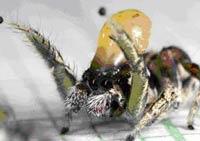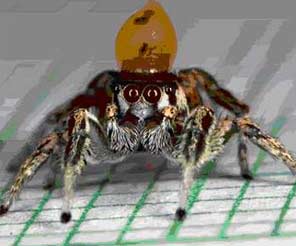Male jumping spiders require their mates to dance and sing before “offering their bodies” to them.
 |
|
A male spider raises his legs in a courting dance. If the abdomen is fixed to the head, they cannot “sing”. (Image: Discovery) |
It is well-known that birds sing and bees dance, but the inclusion of spiders in the courtship narrative of the animal kingdom is relatively new. It demonstrates that spiders have much more complex communication behaviors than previously thought.
Researcher Damian Elias, specializing in behavior and neuroscience at Cornell University in the United States, observed the jumping spider species Habronattus dossenus and recorded their mate attraction behaviors.
This species of spider “sings” by producing various vibrations from its abdomen. Elias prevented some of the spiders from making sounds by fixing their abdomens to their heads with beeswax.
He noted that male spiders who both sang and danced were more successful in attracting females. In contrast, those who only danced without singing received less attention. This indicates that sensory perception of singing, along with the validation of dance behaviors in females, are crucial factors in the mating activities of jumping spiders.
Elias explains that spiders do not have ears, but instead possess tiny sensory organs on their legs that can detect vibrations.
“The same happens to us when we hear loud music with heavy bass. Instead of hearing with our ears, we feel the bass through our bodies,” Elias said.
He mentioned that humans can even hear the songs of spiders in certain circumstances, such as when they sing on a leaf and the vibrations create a high-pitched sound.
 |
|
Jumping spider Habronattus dossenus |
According to Elias, the dances and songs of male spiders vary greatly, but always consist of three components – rustling, thumping, and buzzing.
“What is interesting about their song is that these three components combine to create a melody, where the song begins with a series of rustles, punctuated by some simple thumps, and then gradually intensifies with a series of thumps and buzzes. The entire performance lasts from 1 minute to 20 minutes.”
Since these spiders hunt by lurking and then pouncing, much like a cat catching a mouse, Elias speculates that the impressive song and dance is a way for males to signal to females that they are skilled predators with good physical condition. Conversely, females may view dancers who cannot sing as lower-quality males.
The variety in these vibrational songs seems unique to the Habronattus jumping spiders. The specific species that Elias studied is not necessarily the best performer. For instance, male Habronattus coecatus have been known to have at least 10 different songs for their performances, lasting up to 45 minutes.
Steven Heydon, a scientist at the Bohart Museum of Entomology at the University of California, is not surprised by the findings. “You have to imagine living in the three-dimensional space of a spider. A female spider under a leaf cannot see a male above that leaf. A signal is needed for him to communicate with her in three-dimensional space.”
Heydon also explains: “Many predatory insects do not have much brainpower, so either the male or female has to do something to avoid being eaten by their mate. Some spiders present food as gifts, while in this case, a song and dance would be beneficial.”


















































